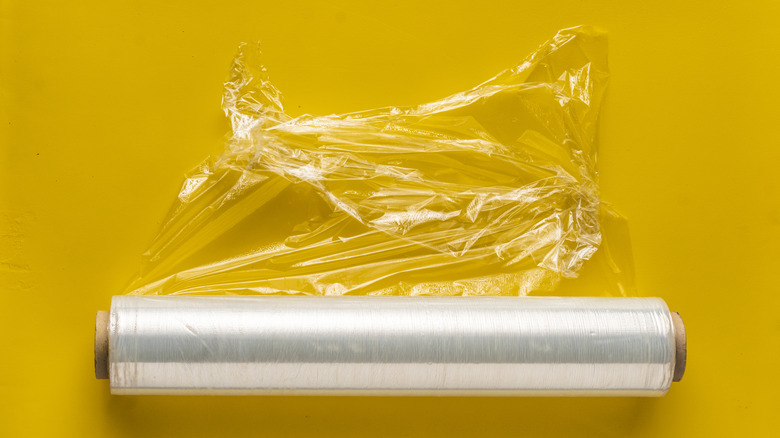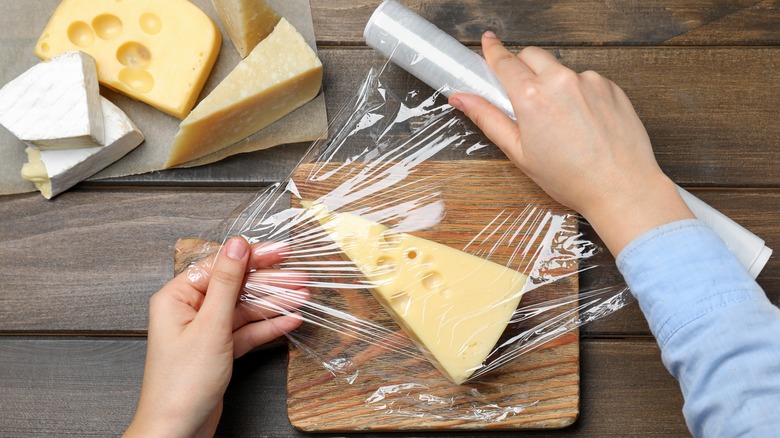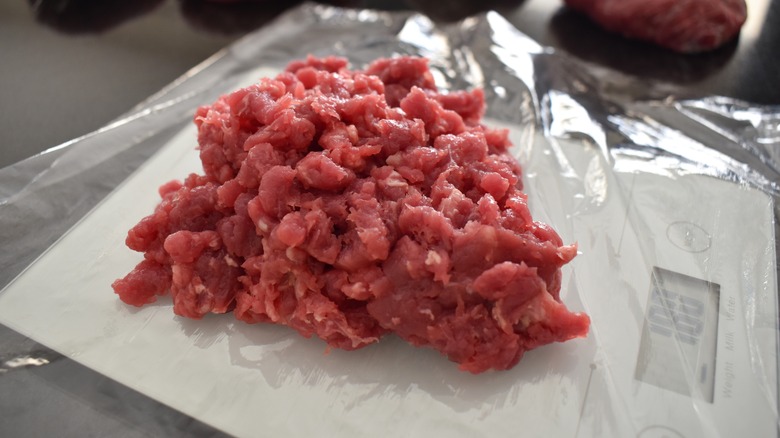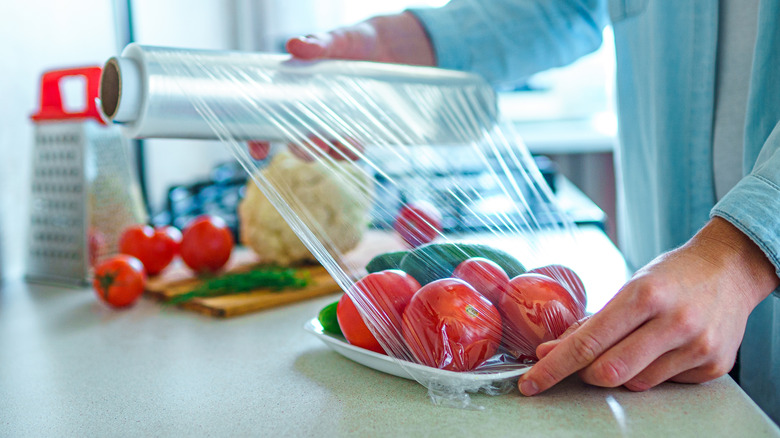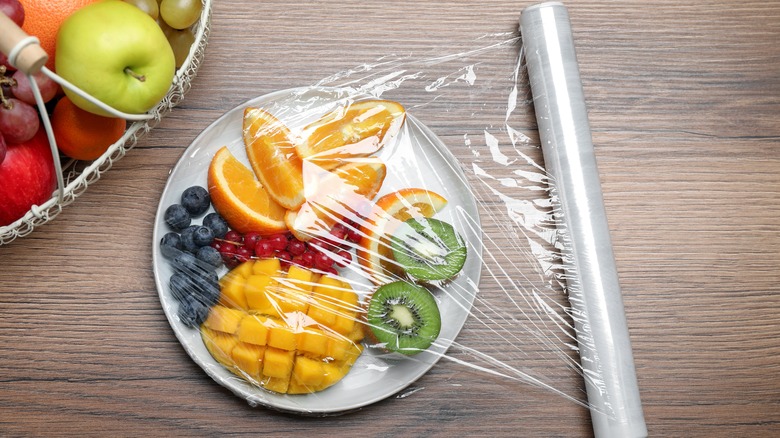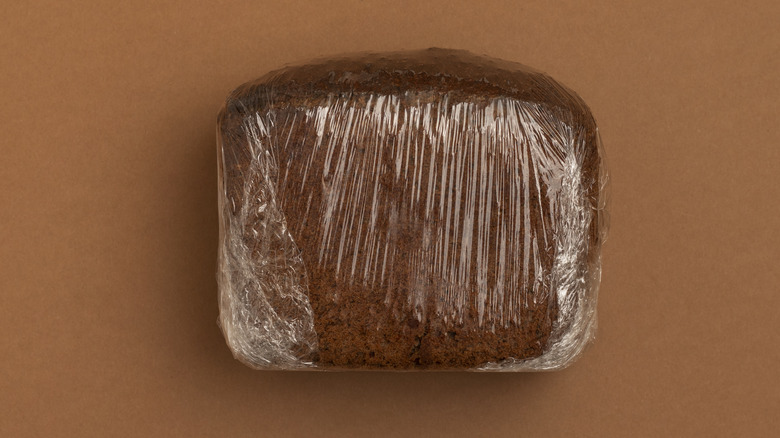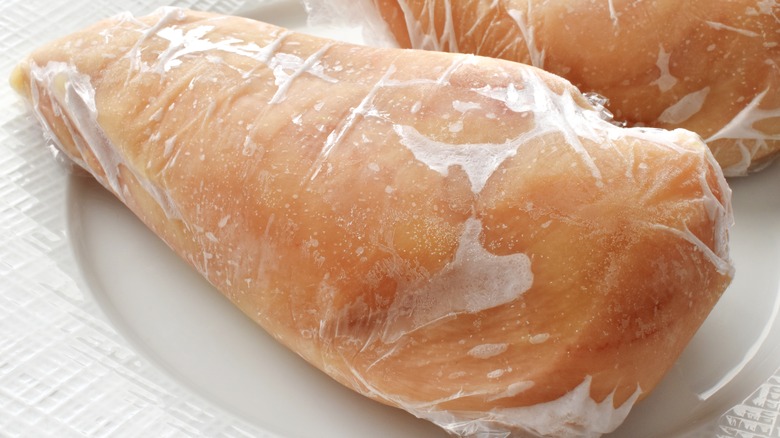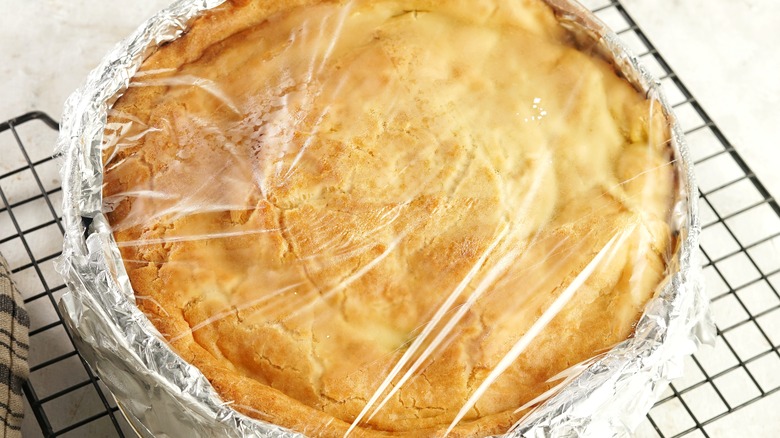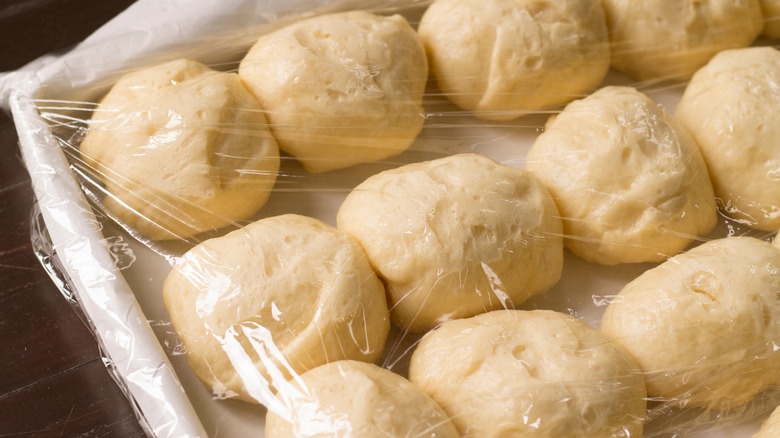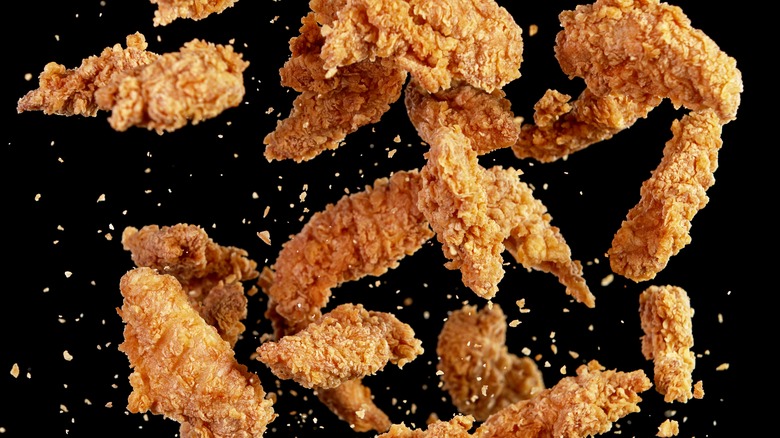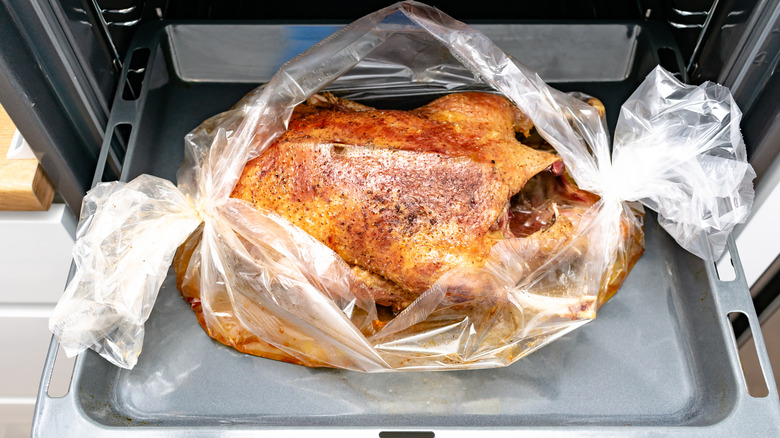10 Foods You Shouldn't Be Wrapping In Plastic Wrap
Plastic has been getting a bad rap in recent years. Turns out it may not be the best way to wrap all your foods, even though many of us have been using it for years. This plastic film has undergone a metamorphosis since its invention. Plastic cling wraps were initially made from polyvinyl chloride or PVC. This is the same material used to make pipes for plumbing. Phthalates were added to make it flexible enough to use as a wrap, but they proved toxic. They interfere with the way hormones work, which eventually resulted in a change in chemical makeup.
The plastic used was swapped out but contains different chemicals that could be as harmful or, worse yet, carcinogenic. Unfortunately, it is also a really efficient way to wrap foods for storage, which is why it continues to be manufactured and used in kitchens everywhere. The good news is that there are safer ways to use it.
First, don't let your plastic wrap touch the food you're wrapping. Plan to wrap casseroles or other items that come in dishes rather than individual items. This will prevent exposure of your food to the chemical contents of the wrap. You should also avoid heating items wrapped in or covered with plastic, when possible, even when the plastic isn't touching your food. Heat causes the chemicals to be released quickly and more easily. To help you out even more, we've compiled a number of foods you should avoid wrapping in plastic wrap.
Cheese
If there's one food you should stop wrapping in plastic, it's cheese. This seems counterintuitive, of course, since so many cheeses come from the store wrapped in plastic. But it can very negatively affect your cheese. First, consider that this already breaks one of the first rules we've discussed: don't let your plastic wrap touch the item you're wrapping. Since plastic wrap will cling to the surface of your cheese, there is a higher likelihood of chemicals leaching into it. It can also leave your cheese with a plastic flavor. But those aren't the only reasons.
You also want to avoid using plastic wrap on cheese because it is airtight. That might sound like a good thing, but it isn't for cheeses because they need to breathe. Cheeses are not only made of milk but also rennet. If the cheese cannot breathe, it can't release the rennet, which can in turn make you sick. Bacteria can grow inside your plastic-wrapped cheese, causing allergic reactions or toxicity. Airtight wraps also prevent the escape of ammonia from your cheese, which can affect its flavor. The best options when wrapping cheeses are to use parchment, wax, or paper designed specifically for cheeses.
Aluminum foil can also be used, or you could wrap it in paper and foil if you plan to keep it for an extended period. These wraps allow your cheese to breathe while keeping it from drying out. Storing it in your refrigerator's snack or vegetable drawer will also ensure it lasts longer.
Beef
Steak, ground beef, and other cuts of red meat come from the store prepacked in plastic, but that doesn't mean you should keep it in that plastic. And you shouldn't wrap them in plastic for storage once you get them home, either. These store wraps aren't always tight, and products can leak on themselves, other items in your grocery cart, fridge or freezer, and your hands. This exposes you to potential pathogens like E.coli from raw beef.
They recommend buying frozen meats, but what if that's not an option? Your best bet is to wrap your raw beef in freezer paper or a poly-coated version. The coated side should be against the meat. Once wrapped, seal it with freezer-safe tape and label it to make it easy to identify later.
You should lay your cuts of meat flat in the freezer until they are frozen solid, and then you can stack them. Some cuts will freeze faster than others, allowing everything to freeze thoroughly before stacking. If you don't have freezer paper either, you can wrap your beef in aluminum foil first, then add a layer of freezer-safe plastic wrap. This will prevent the plastic from coming in direct contact with your meat but still seal it tightly so you can avoid freezer burn.
Vegetables
Despite the recent drive for environmental sustainability, many vegetables come pre-packed in plastic. Manufacturers use this packaging because it is convenient for consumers. It also helps hygienically since people in stores tend to handle vegetables as they pick out the ones to purchase, leaving behind germs for the next shopper.
But all the plastic isn't good for your vegetables, and most of them require peeling before you use them anyway, making the wrapping unnecessary. Ones that don't need to be peeled can be washed. Furthermore, wrapping your vegetables in airtight plastic wrap prevents their ability to breathe, which can cause them to spoil more quickly. The best way to store most vegetables is in the crisper drawer of your refrigerator, with space around the items to allow air to circulate.
Items wrapped in plastic from the store are often overfilled, resulting in congestion that can lead to mildewing or premature spoilage. Root vegetables like potatoes and yams and bulbs like garlic and onions do best outside the fridge, in dry, dark storage, while items like carrots, cucumbers, and peppers should go in a drawer in the fridge where you can control the temperature. Set it to less than 5 degrees Fahrenheit for the best results. This will result in a shelf life often days, weeks, or even months longer than vegetables stored in plastic.
Fruit
Like vegetables, you shouldn't be storing your fruit in plastic wrap or even plastic containers if you can avoid it, because fruit sweats when you wrap it in airtight plastic. Plastic also traps the gases naturally produced by your fruit, exposing them to higher concentrations. Both those natural gases and condensation cause your fruit to ripen faster. If you leave them in plastic for too long, it will cause them to decay.
In other words, if you're storing your fruit in plastic, you may inadvertently be causing it to spoil more quickly than if you just tossed them into the produce drawer of your fridge. Just make sure you're not putting them in the same drawer as your vegetables. The ethylene gas each emits can cause the rest of your produce to ripen too quickly.
Fortunately, there are plenty of other storage options available. You can use glass or steel containers with lids or bowls covered with beeswax wraps which allow your fruits to breathe. Mason jars also make excellent storage containers for fruits, but there are a few things you'll need to keep in mind. Because they are also airtight, you must keep an eye on your jars. Remove and dry the fruit you're storing if you notice condensation inside the jars. You also need to wash your fruit before it goes in the jars using a mix of water and distilled vinegar.
Bread
You can use plastic wrap for the store-bought variety, but it's not the best option. And if you're making the bread yourself, you definitely shouldn't be wrapping it in plastic. You can use a bread bag, a bread box, or both together. This is an excellent option if you favor crusty bread because the more exposure your bread has to the air, the crispier its crust will be.
Even if you don't want a super crispy crust, you shouldn't keep your loaves of bread in plastic, especially if they're homemade. You want to avoid this practice with your bread for the same reasons you shouldn't be using it on your produce. Plastic is airtight, which allows things to sweat. Sweating bread can quickly mold and turn rancid.
If you're making bread fresh at home, leaving it uncovered on your counter the day you bake it is essential. This gives your bread a chance to breathe, which is vital to its flavor later on. And while you can freeze your bread, you should avoid keeping it in the refrigerator. Your bread will actually become stale three times faster in the refrigerator than sitting at room temperature on your counter. If you plan to keep your bread for more than 2-3 days, you should freeze it. Wrap it in heavy-duty foil and label it so it doesn't become anonymous later in your freezer.
Chicken
Like beef, you shouldn't be wrapping your chicken in plastic wrap. While many people wrap their chicken in plastic before putting it in the freezer, it's not the best option for meats. Air can get trapped in the plastic wrap and retains moisture, which can cause your chicken (or other meat) to become stagnant.
Foil is safe for your chicken but can leave a metallic taste behind. Wax paper can be used but is hard to label, and parchment and butcher papers aren't sturdy enough to withstand freezer temperatures. Freezer paper, however, was designed for this task. And it's a great way to wrap chicken you have separated when you get home from the grocery store.
As we've already discussed, you shouldn't leave meats in the plastic packaging they come from the store in. This is imperative with chicken, where there is an increased risk of salmonella. But when you get home and are rewrapping your items for storage, you should also consider portioning your chicken. Unless you have a large family and will be using all the chicken at once, dividing it into amounts you will use is a wise decision. If you freeze the whole package, it may be impossible to separate the amount you want later without thawing the entire package of chicken. And while you can refreeze meat if you've thawed it correctly, doing so repeatedly can negatively affect its consistency.
Puddings and custards
Technically, you can wrap items like puddings and custards in plastic, but you should avoid touching the surface with them. This is particularly difficult with custards, puddings, and even mousse because plastic wrap has often been used to prevent film from forming on its surface. For years, cooks have been told that this is a necessary step, and that preventing skin from forming is essential. The film forms because of the liquid that evaporates off your pudding-type dessert's top surface. While it doesn't affect the flavor of your dessert, it will negatively impact its appearance.
Improvements have been made to plastic wrap in recent years, like the removal of plasticizers which are most likely to wreak havoc. But chemicals in plastic wraps are more likely to cause problems when exposed to warm, fatty foods. Unfortunately, puddings and custards fall into this category. So, the risk is likely not worth it.
Fortunately, there are some ways to avoid plastic wrap and keep the film from forming on your custards. You should try using parchment on the top surface of these items. If you don't have any parchment on hand, you can also use wax paper. Both of these will seal the surface of your puddings without leaching toxic chemicals into your dessert.
Bread dough
The common wisdom is that plastic wrap is the best option when covering your dough to let it rise. After all, you need something to keep it from drying out. But for environmental reasons, you may be looking for other options. And because dough gives off heat as it rises, there are potential risks of chemical contamination.
There are several ways to cover your dough to let it rise when you don't want to use plastic wrap. One of the oldest but wisest choices is a wet dishtowel, but you need a warm house for this to work or the dough won't get to the temperature it needs to rise properly.
If your house is too cool for a towel to work, try using plastic or glass containers with lids. This still seals the container, allowing the heat the bread produces as it rises to work effectively. If your containers don't have lids, try covering them with plates instead. You can also use aluminum foil, but this may not be the best option if you are trying to be sustainable and reap the health benefits of using less plastic. You can only use foil once. For something that works repeatedly, consider just turning your lidless bowl over. It will seal against the counter and allow the bread to rise in the warm environment it requires.
Fried foods
There's a simple reason not to wrap your fried foods in plastic — it has no ventilation. Without proper ventilation, putting fried foods in anything completely airtight will turn your fried foods soggy. This happens because food taken from the hot fryer releases steam as it cools. Wrapping it in plastic wrap seals all the extra moisture in your fried foods. Doing so will keep your food warm but also make it soggy.
Need more proof that ventilation is key with these items? Consider copying what fried fast-food joints do. Most of the food these restaurants serve comes in cardboard serving trays or buckets with ventilated tops or bottoms. And you should also consider using parchment paper or all-natural beeswax wraps. They will let your food breathe in ways that plastic wrap will not.
Absorbent materials also help keep your food crispy when traveling. Using paper towels or cloth will help to absorb the moisture that naturally escapes your fried food. And if you're traveling long distances with your fried food, you should let it cool completely before putting it in any packaging. This will help prevent the steam from forming in the first place. If you avoid wrapping your fried foods in plastic wrap and use well-ventilated containers, the result will be much more impressive.
Anything going into the oven
This a matter of considerable debate, and pros argue it can be done under certain circumstances. But most home cooks should avoid covering anything going in the oven in plastic wrap. While many professional chefs swear by using it in the oven at low temps and covered in foil, most plastic wraps instruct consumers not to use their products in the oven.
It is important to note that chefs recommend using only commercial-grade plastic wraps in the oven. They agree with the manufacturers that household varieties of plastic wrap are too thin and will melt in the oven's heat. And consumers are also concerned because plastics can release chemicals into the adjacent food at far lower than the melting temperature of the plastic. If you've stored your leftovers that way, ensure you remove all the wrap before putting it in the oven.
An alternative to wrapping meats going in the oven is to use an oven bag. These are also made of plastic, but a much heavier variety that withstands temperature better and won't melt or leach chemicals into your food. Even if you're confident that your plastic wrap won't melt in the oven, and you've prepared your wrap and covered it in aluminum foil as directed on cooking shows, it still may be best to avoid using it in the oven. Besides carcinogenic chemicals, there is also the risk of ingesting endocrine-disrupting chemicals which disrupt hormonal routines, per Environmental Health News).
